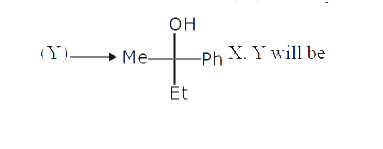Carbonyl compounds are reduced to alcohols by hydride reagents. This reduction involves
addition of two hydrogens across a <C=O bond
reduction of carbonyl group to an alkoxide which protonated to alcohol
Both (1) and (2)
None of the above
The correct Answer is:C
Similar Questions
Carbonyl compound (X) + Grignard reagent

View SolutionAction of Grignard reagent on carbonyl compound followed by hydrolysis gives alcohols. In the preparation of all isomeric (structural) butyl alcohols, the number of different carbonyl compounds involved is 'X' and Grignard reagents is 'Y'. Then the value of X+Y is?
View Solution
Knowledge Check
Reaction of carbonyl compound with one of the following reagents involves nucleophilic addition followed by elimination of water. The reagent is:
Ahydrocyanic acidBsodium hydrogen sulphiteCa Grignard reagentDHydrazine in presence of feebly acidic solutionReaction of a carbonyl compound with one of the following reagents involves nucleophilic addition followed by elimination of water. The reagent is
Ahydrazine in presence of feebly acidic solutionBhydrocyanic acidCsodium hydrogen sulphiteDa Grignard reagent.Reaction of carbonyl compound with one of the following reagents involves nucleophilic addition followed by elimination of water. The reagent is:
Ahydrazine in presence of feebly acidic solutionBhydroxyanic acidCsodium hydrogen sulphiteDGrignard reagent
Reaction of carbonyl compound with one of the following reagents involves nucleophilic addition followed by elimination of water. The reagent is:
View SolutionReaction of carbonyl compound with one of the following reagents involves nucleophilic addition followed by elimination of water. The reagent is:
View SolutionReaction of carbonyl compound with one of the following reagents involves nucleophilic addition followed by elimination of water. The reagent is:
View SolutionIn carbonyl compounds the carbon atom involves ....... hybridisation.
View SolutionWhich of these carbonyl compounds on reduction with Zn-Hg/HCI will give the same product ?
View Solution
